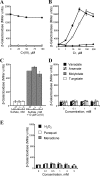The chromate-inducible chrBACF operon from the transposable element TnOtChr confers resistance to chromium(VI) and superoxide
- PMID: 18776016
- PMCID: PMC2580707
- DOI: 10.1128/JB.00289-08
The chromate-inducible chrBACF operon from the transposable element TnOtChr confers resistance to chromium(VI) and superoxide
Abstract
Large-scale industrial use of chromium(VI) has resulted in widespread contamination with carcinogenic chromium(VI). The abilities of microorganisms to survive in these environments and to detoxify chromate require the presence of specific resistance systems. Here we report identification of the transposon-located (TnOtChr) chromate resistance genes from the highly tolerant strain Ochrobactrum tritici 5bvl1 surviving chromate concentrations of >50 mM. The 7,189-bp-long TnOtChr of the mixed Tn21/Tn3 transposon subfamily contains a group of chrB, chrA, chrC, and chrF genes situated between divergently transcribed resolvase and transposase genes. The chrB and chrA genes, but not chrF or chrC, were essential for establishment of high resistance in chromium-sensitive O. tritici. The chr promoter was strongly induced by chromate or dichromate, but it was completely unresponsive to Cr(III), oxidants, sulfate, or other oxyanions. Plasmid reporter experiments identified ChrB as a chromate-sensing regulator of chr expression. Induction of the chr operon suppressed accumulation of cellular Cr through the activity of a chromate efflux pump encoded by chrA. Expression of chrB, chrC, or chrF in an Escherichia coli sodA sodB double mutant restored its aerobic growth in minimal medium and conferred resistance to superoxide-generating agents menadione and paraquat. Nitroblue tetrazolium staining on native gels showed that ChrC protein had superoxide dismutase activity. TnOtChr appears to represent a mobile genetic system for the distribution of the chromate-regulated resistance operon. The presence of three genes protecting against superoxide toxicity should provide an additional survival advantage to TnOtChr-containing cells in the environments with multiple redox-active contaminants.
Figures







References
-
- Beauchamp, C., and I. Fridovich. 1971. Superoxide dismutase: improved assays and an assay applicable to acrylamide gels. Anal. Biochem. 44276-287. - PubMed
Publication types
MeSH terms
Substances
Grants and funding
LinkOut - more resources
Full Text Sources
Other Literature Sources

